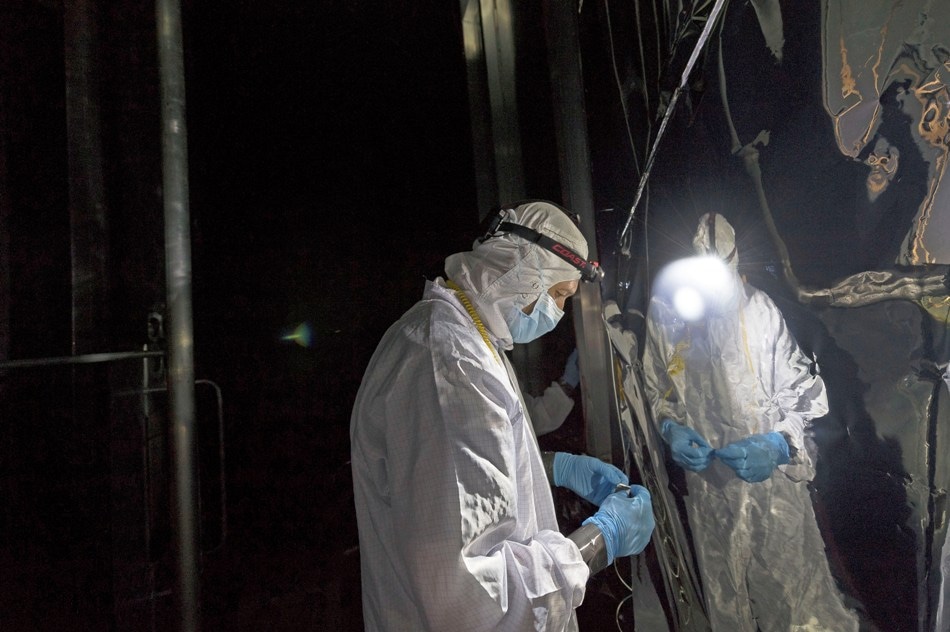Sep 13 2017
In a recent photograph taken at Chamber A of NASA’s Johnson Space Center in Houston, a bunny-suited technician is seen performing the important task of guaranteeing that no unwanted infrared light interferes with the optical testing of NASA’s James Webb Space Telescope inside this chamber.
 Eric Zoller, a Technician from Harris Corporation, headquartered in Melbourne, Florida, checks the helium shroud in Chamber A at NASA’s Johnson Space Center on July 12, 2017. Credits: NASA/Chris Gunn
Eric Zoller, a Technician from Harris Corporation, headquartered in Melbourne, Florida, checks the helium shroud in Chamber A at NASA’s Johnson Space Center on July 12, 2017. Credits: NASA/Chris Gunn
The shroud was made almost impervious to outside light sources capable of contaminating the testing due to the Webb telescope’s extreme sensitivity to infrared light.
“One of the challenges of testing an infrared telescope is that room-temperature objects (such as the walls of the vacuum chamber itself, or the warm electronics systems inside it) glow at the wavelengths of light that the telescope is trying to measure,” explained Randy Kimble, a scientist at NASA’s Goddard Space Flight Center in Greenbelt, Maryland, who is helping conduct optical testing of the telescope. “If not carefully controlled, that warm glow can provide an unwanted background in the telescope's images, which would compromise the optical testing.”
The cold gaseous helium shroud within Chamber A is considered to be the innermost of two shrouds employed for cooling the Webb telescope down to the temperatures at which it will operate while in orbit. This shroud rests inside an outer liquid nitrogen shroud, and the Technician actually stands in the space between them. A photo with this Technician was taken before all of the air was removed from the chamber and it started to cool to cryogenic temperatures.
The two shrouds are cylindrical, thin, metal shells that operate together in order to lower the temperature of the area in which the telescope sits. They are nested within the chamber like Russian Matryoshka dolls that in fact sit inside each other. The chamber is considered to be the largest “doll,” which is followed by the liquid nitrogen shroud, the cold gaseous helium shroud, and lastly the smallest “doll” — the Webb telescope. The cold gaseous helium and the liquid nitrogen flow via plumbing that crisscrosses the surface of their corresponding shrouds.
In order to ensure that unwanted infrared light is unable to interfere with the telescope, it is particularly important to protect the shroud doors, which provide access to the shrouds’ interiors. Kimble stated that a layer of black Kapton, a thin, opaque, plastic film perfect for use in a vacuum was employed by Engineers to curtain the door into the cold gaseous helium shroud. This Kapton curtain is capable of curtailing the amount of light that can enter the shroud via the seam around the door.
An aluminized polyester sheet, a mercury-like, reflective material, was placed over the black Kapton curtain. The liquid-metal look observed on that covering and the strange, distorted reflection it provides are to some extent caused by the amount of play the curtain should have.
The Kapton material…shrinks a lot as it cools, so we needed to make sure that it was not taped down so tightly that it would tear during cooldown.
Randy Kimble, Scientist, NASA’s Goddard Space Flight Center, Greenbelt, Maryland
Kimble is affectionately known as the “Prince of Darkness,” a moniker in which he takes pride, because of his work ensuring that the test environments at both Goddard and Johnson for the Webb telescope and its instruments were dark enough for optical testing. “I like it,” said Kimble. “If the chamber is appropriately dark, then I've done my job.”
In spite of the royal nickname, Kimble highlighted that it was because of a team effort that the telescope was ensured to be properly insulated from outside infrared light in Chamber A.
Many people have worked for years on the test design and implementation to keep infrared light, from warm sources in the test chamber, from getting into the telescope beam. The final visual inspections and blanket closeouts…are just the icing on that well-baked cake.
Randy Kimble, Scientist, NASA’s Goddard Space Flight Center, Greenbelt, Maryland
The James Webb Space Telescope is considered to be the scientific complement to NASA's Hubble Space Telescope. It will indeed be the most powerful space telescope that has ever been built. Webb is an international project headed by NASA with its partners, ESA (European Space Agency) and the Canadian Space Agency.